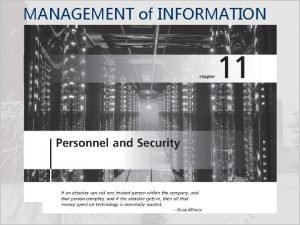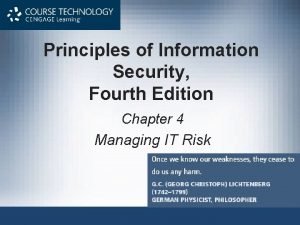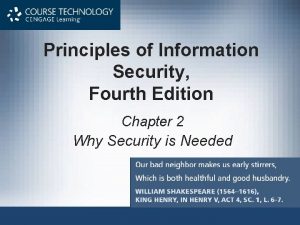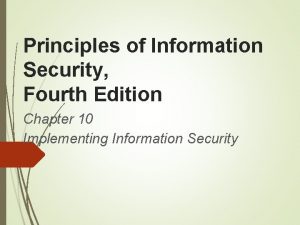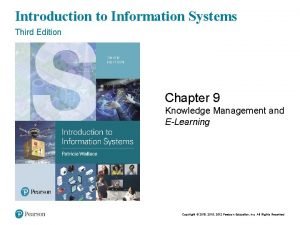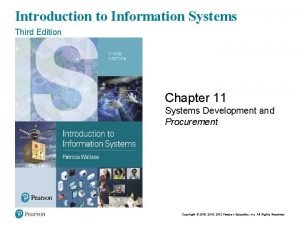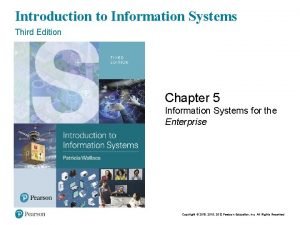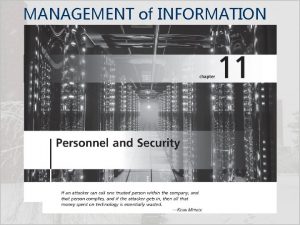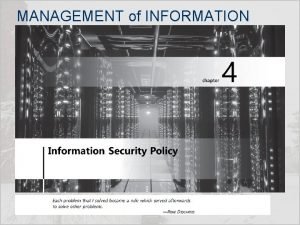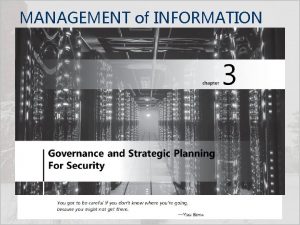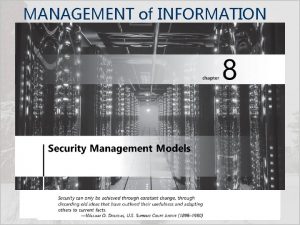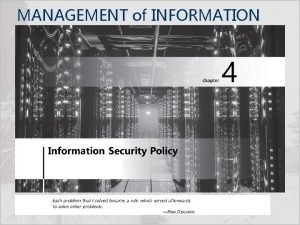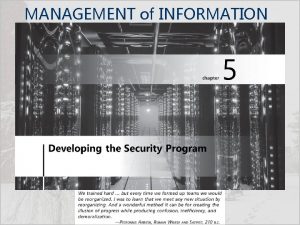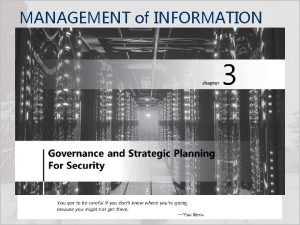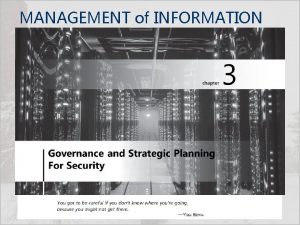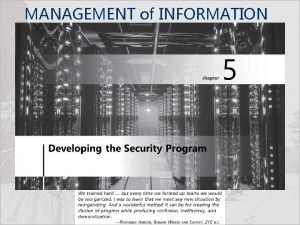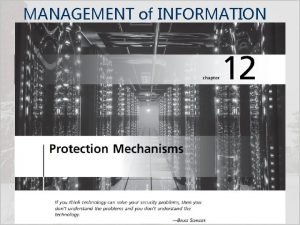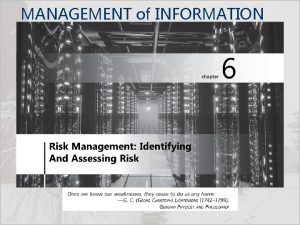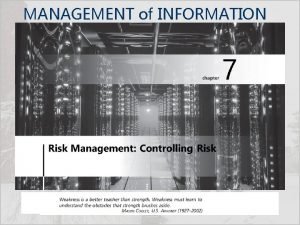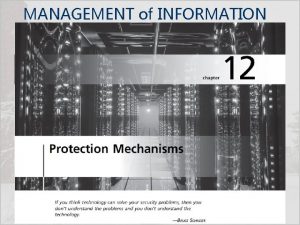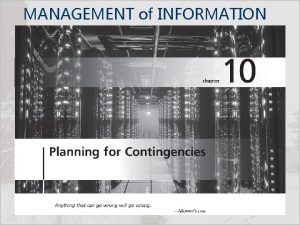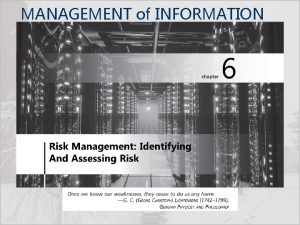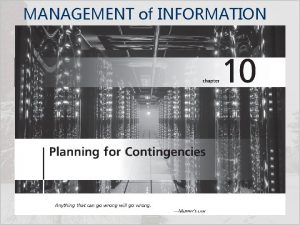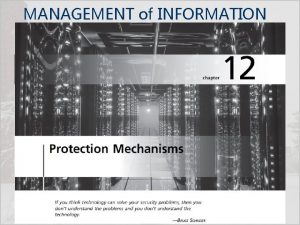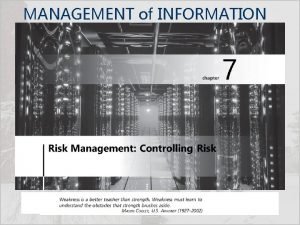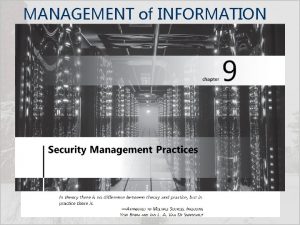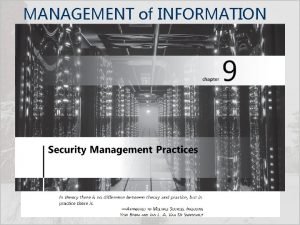MANAGEMENT of INFORMATION SECURITY Fifth Edition INTRODUCTION TO























- Slides: 23

MANAGEMENT of INFORMATION SECURITY, Fifth Edition

INTRODUCTION TO SECURITY MANAGEMENT MODELS Management of Information Security, 5 th Edition, © Cengage Learning 2

Introduction • Info. Sec models are standards that are used for reference or comparison and often serve as the stepping-off point for emulation and adoption • One way to select a methodology is to adapt or adopt an existing security management model or set of practices • Because each Info. Sec environment is unique, you may need to modify or adapt portions of several frameworks; what works well for one organization may not precisely fit another Management of Information Security, 5 th Edition, © Cengage Learning 3

Blueprints, Frameworks and Security Models • The communities of interest accountable for the security of an organization’s information assets must design a working security plan and then implement a management model to execute and maintain that plan • This may begin with the creation or validation of a security framework, followed by an Info. Sec blueprint that describes existing controls and identifies other necessary security controls • A framework or security model is the outline of the more thorough and organization-specific blueprint • These documents form the basis for the design, selection, and initial and ongoing implementation of all subsequent security controls, including policy, SETA and Management technologies of Information Security, 5 th Edition, © Cengage Learning 4

Blueprints, Frameworks and Security Models • To generate a usable security blueprint, most organizations draw on established security frameworks, models, and practices • Another way to create a blueprint is to look at the paths taken by other organizations • In this kind of benchmarking, you follow the recommended practices or industry standards Management of Information Security, 5 th Edition, © Cengage Learning 5

ACCESS CONTROL MODELS Management of Information Security, 5 th Edition, © Cengage Learning 6

Access Control Models • Access controls regulate the admission of users into trusted areas of the organization— both the logical access to the information systems, or the physical access to the organization’s facilities • Access control is maintained by means of a collection of policies, programs to carry out those policies, and technologies that enforce policies Management of Information Security, 5 th Edition, © Cengage Learning 7

Access Control Models • The general application of access control comprises four processes: – obtaining the identity of the entity requesting access to a logical or physical area (identification) – confirming the identity of the entity seeking access to a logical or physical area (authentication) – determining which actions an authenticated entity can perform in that physical or logical area (authorization) – and finally, documenting the activities of the authorized individual and systems (accountability) Management of Information Security, 5 th Edition, © Cengage Learning 8

Access Control • Access control is built on several key principles: – Least privilege: The principle by which members of the organization can access the minimum amount of information for the minimum amount of time necessary to perform their required duties – Need to Know: Limits a user’s access to the specific information required to perform the currently assigned task, and not merely to the category of data required for a general work function – Separation of Duties: A control requiring that significant tasks be split up in such a way that more than one individual is responsible for their completion Management of Information Security, 5 th Edition, © Cengage Learning 9

Categories of Access Controls • Directive—Employs administrative controls such as policy and training designed to proscribe certain user behavior in the organization • Deterrent—Discourages or deters an incipient incident • Preventative—Helps an organization avoid an incident • Detective—Detects or identifies an incident or threat when it occurs • Corrective—Remedies a circumstance or mitigates damage done during an incident • Recovery—Restores operating conditions back to normal • Compensating—Resolves shortcomings Management of Information Security, 5 th Edition, © Cengage Learning 10

Categories of Access Controls Management of Information Security, 5 th Edition, © Cengage Learning 11

NIST Control Categories • Management—Controls that cover security processes that are designed by strategic planners, integrated into the organization’s management practices, and routinely used by security administrators to design, implement, and monitor other control systems • Operational (or Administrative)—Controls that deal with the operational functions of security that have been integrated into the repeatable processes of the organization • Technical—Controls that support the tactical portion of a security program and that have been implemented as reactive mechanisms to deal with the immediate needs of the organization as it responds to the realities of the technical environment Management of Information Security, 5 th Edition, © Cengage Learning 12

Examples of Controls Management of Information Security, 5 th Edition, © Cengage Learning 13

Mandatory Access Controls (MACs) • A Mandatory Access Control (MAC) is required and is structured and coordinated within a data classification scheme that rates each collection of information as well as each user • These ratings are often referred to as sensitivity levels or classification levels • When MACs are implemented, users and data owners have limited control over access to information resources Management of Information Security, 5 th Edition, © Cengage Learning 14

Data Classification Model • Data owners must classify the information assets for which they are responsible and review the classifications periodically • The U. S. military classification scheme relies on a more complex four-level classification scheme as defined in Executive Order 13526. There are three levels of classified data, and then unclassified: – – Top Secret Data Confidential Data Unclassified Data • Simple scheme for other organizations: – Public – For official (or internal) use only – Confidential (or Sensitive) Management of Information Security, 5 th Edition, © Cengage Learning 15

Security Clearances • In a security clearance structure, each user of an information asset is assigned an authorization level that indicates the highest level of information classification they may access • Most organizations have developed roles and corresponding security clearances so individuals are assigned into authorization levels correlating with the classifications of the information assets • In the need-to-know principle, regardless of one’s security clearance, an individual is not allowed to view data simply because it falls within that individual’s level of clearance Management of Information Security, 5 th Edition, © Cengage Learning 16

Managing Classified Information Assets • Managing an information asset includes all aspects of its life cycle—from specification to design, acquisition, implementation, use, storage, distribution, backup, recovery, retirement, and destruction • An information asset that has a classification designation other than unclassified or public must be clearly marked as such – with a cover page and headers & footers • To maintain the confidentiality of classified documents, managers can implement a clean desk policy – requiring employees to secure all information in an appropriate storage container at the end of each business day Management of Information Security, 5 th Edition, © Cengage Learning 17

Managing Classified Information Assets • When copies of classified information are no longer valuable or too many copies exist, care should be taken to destroy them properly to discourage dumpster diving • While bins stored on private property can be protected from trespassers, in 1998, the Supreme Court ruled that there is no expectation of privacy for items thrown away in trash or refuse containers Management of Information Security, 5 th Edition, © Cengage Learning 18

Government Data Classification Cover Sheets Management of Information Security, 5 th Edition, © Cengage Learning 19

Lattice-Based Access Controls • A variation on the MAC form of access control, Lattice-Based Access Controls assigns users a matrix of authorizations for particular areas of access • The level of authorization may vary depending on the classification authorizations that individuals possess for each group of information assets or resources • The lattice structure contains subjects and objects, and the boundaries associated with each subject/object pair are clearly demarcated Management of Information Security, 5 th Edition, © Cengage Learning 20

Nondiscretionary Controls • Nondiscretionary controls are determined by a central authority in the organization and can be based on roles—called role-based access controls or RBAC—or on a specified set of tasks—called task-based controls • Role-based controls are tied to the role that a particular user performs in an organization, whereas task-based controls are tied to a particular assignment or responsibility Management of Information Security, 5 th Edition, © Cengage Learning 21

Discretionary Access Controls (DACs) • Discretionary Access Controls (DACs) are implemented at the discretion or option of the data user • Users can allow general, unrestricted access, or they can allow specific individuals or sets of individuals to access these resources • Most personal computer operating systems are designed based on the DAC model • One discretionary model is rule-based access controls where access is granted based on a set of rules specified by the central authority Management of Information Security, 5 th Edition, © Cengage Learning 22

Other Forms of Access Control • Content-dependent access controls—As the name suggests, access to a specific set of information may be dependent on its content (e. g. Accounting information for the Accounting Department) • Constrained user interfaces—Some systems are designed specifically to restrict what information an individual user can access (e. g. ATMs) • Temporal (time-based) isolation—In some cases, access to information is limited by a time-of-day constraint (e. g. Time-release safes) Management of Information Security, 5 th Edition, © Cengage Learning 23
 Management of information security 5th edition
Management of information security 5th edition Introduction to information systems 5th edition
Introduction to information systems 5th edition Principles of marketing fifth european edition
Principles of marketing fifth european edition Appraisals in lazarus theory of emotion
Appraisals in lazarus theory of emotion Fundamentals of corporate finance fifth edition
Fundamentals of corporate finance fifth edition Democritus atomic model diagram
Democritus atomic model diagram Segregat
Segregat Molecular biology
Molecular biology Human anatomy fifth edition
Human anatomy fifth edition Human anatomy fifth edition
Human anatomy fifth edition Principles of information security 5th edition pdf
Principles of information security 5th edition pdf Information management principles
Information management principles Principles of information security 4th edition
Principles of information security 4th edition 12 principles of information security
12 principles of information security Bulls eye model in information security
Bulls eye model in information security Private securit
Private securit Introduction to information systems 6th edition
Introduction to information systems 6th edition Introduction to information systems 6th edition
Introduction to information systems 6th edition Introduction to information systems 3rd edition
Introduction to information systems 3rd edition Introduction to information systems 3rd edition
Introduction to information systems 3rd edition Introduction to information systems 3rd edition
Introduction to information systems 3rd edition Visa international security model
Visa international security model Cnss model
Cnss model Information technology project management 9th edition
Information technology project management 9th edition
